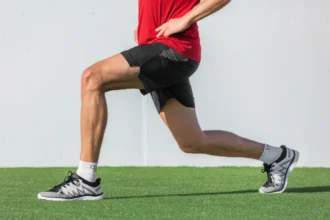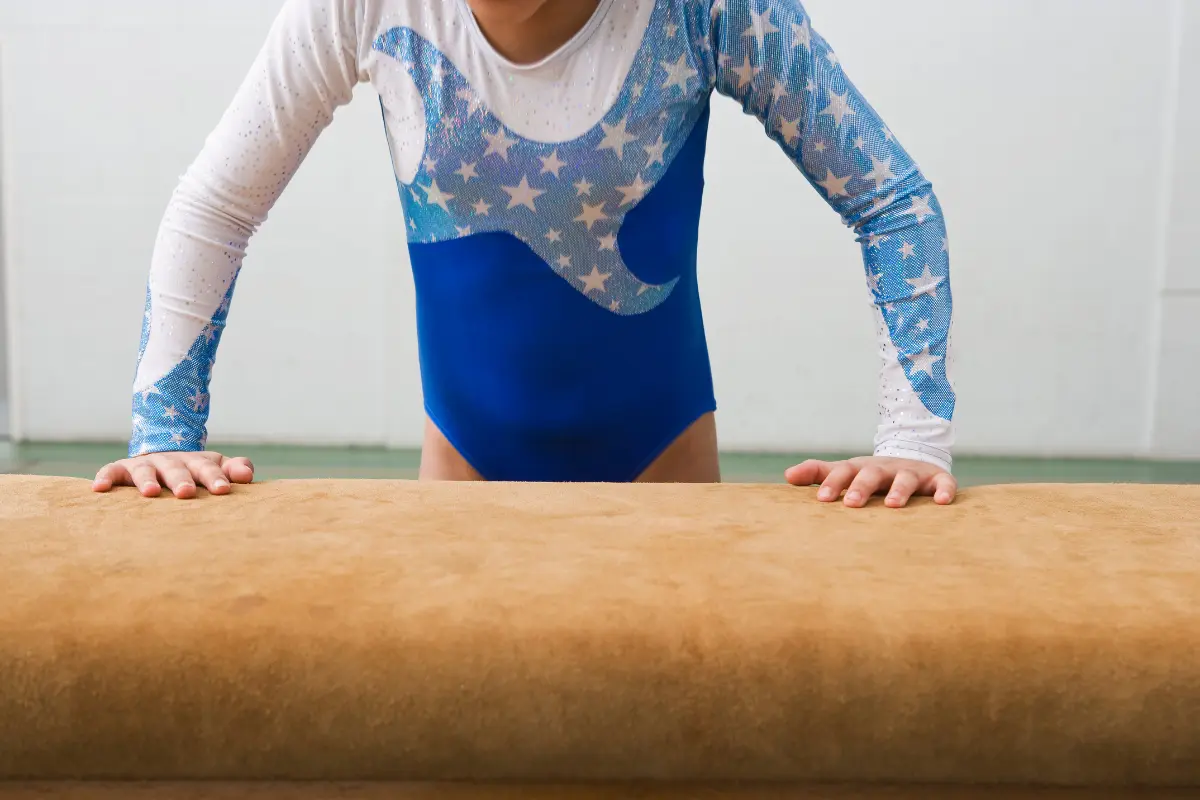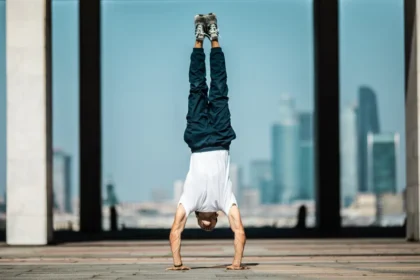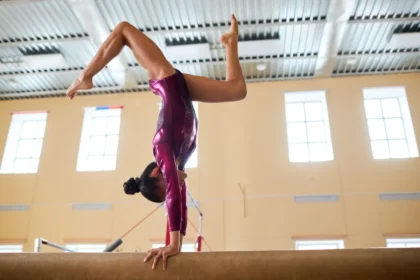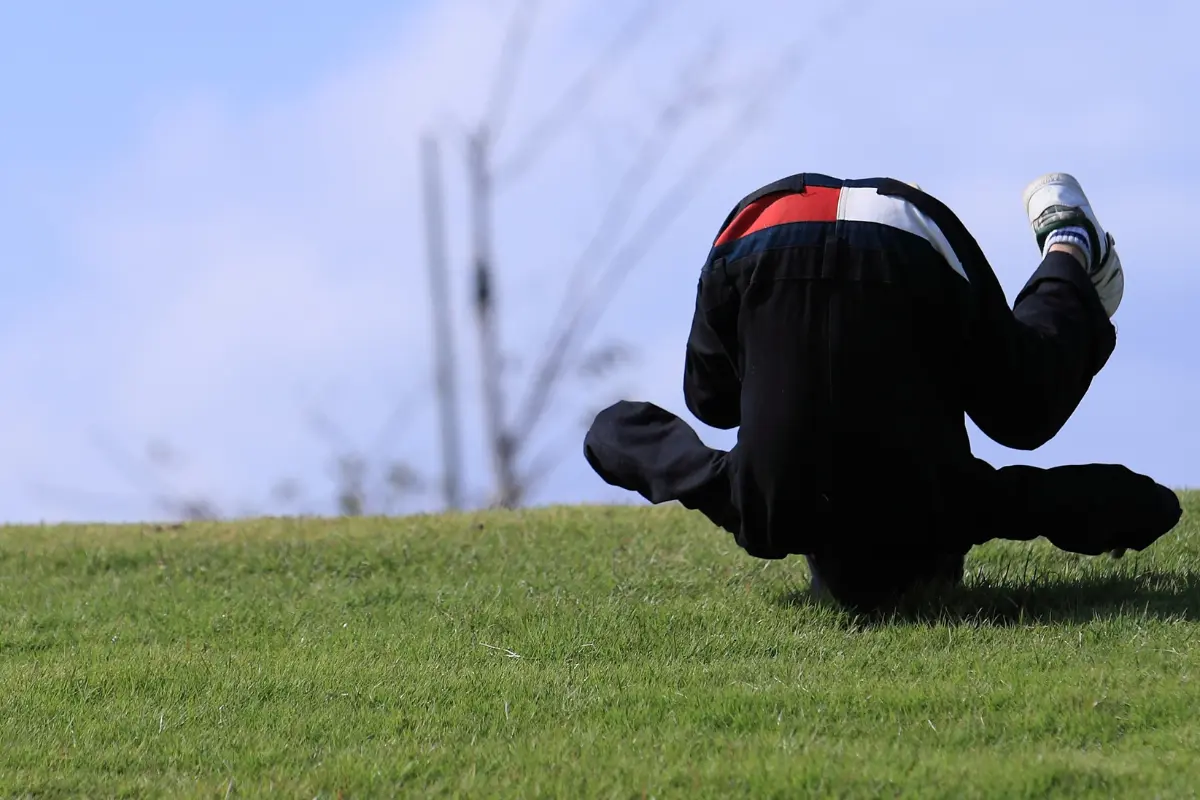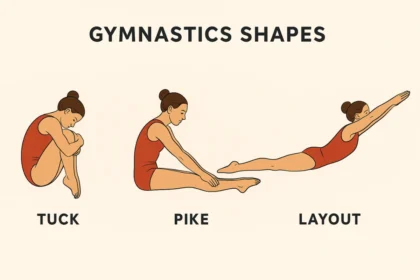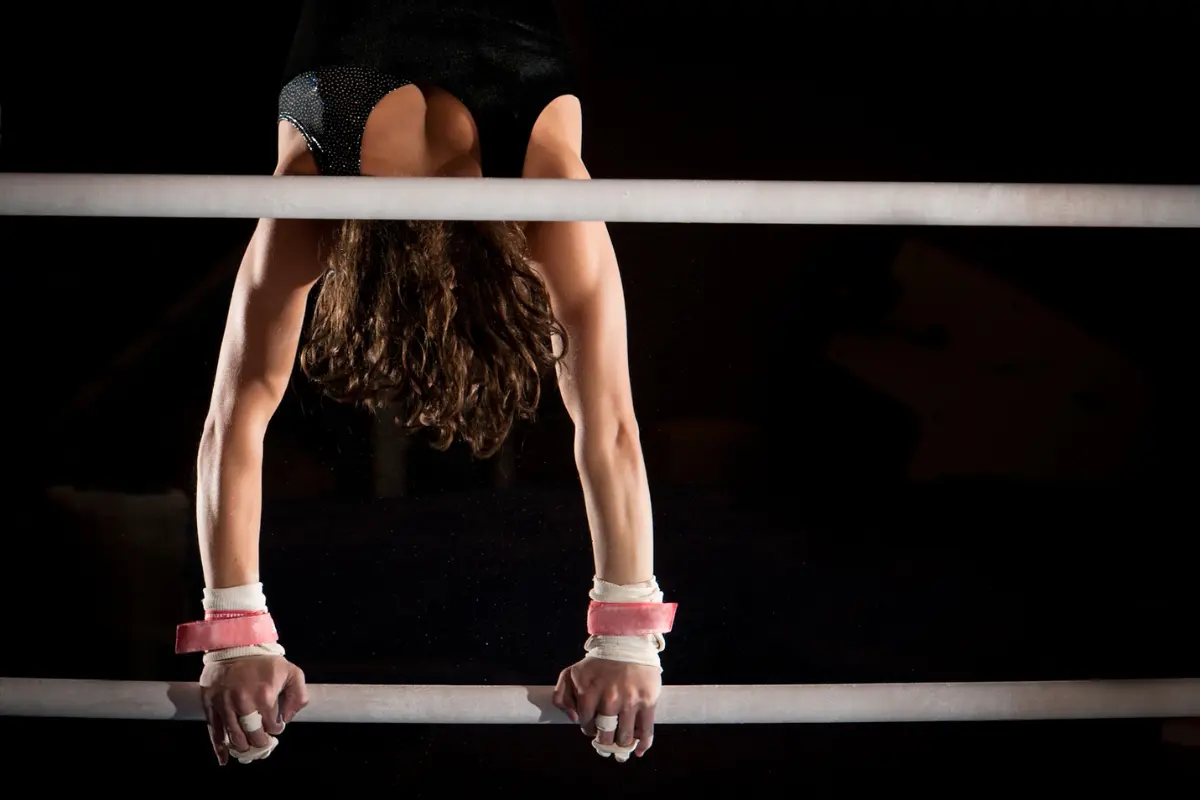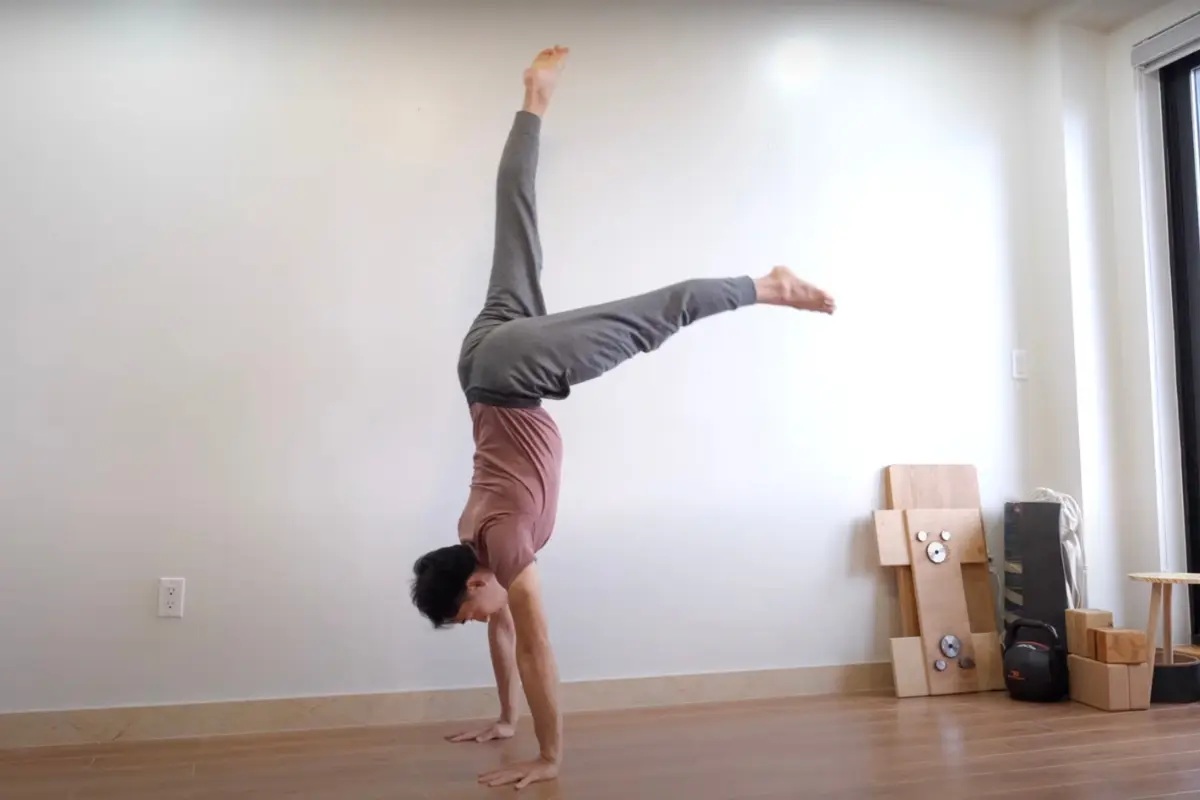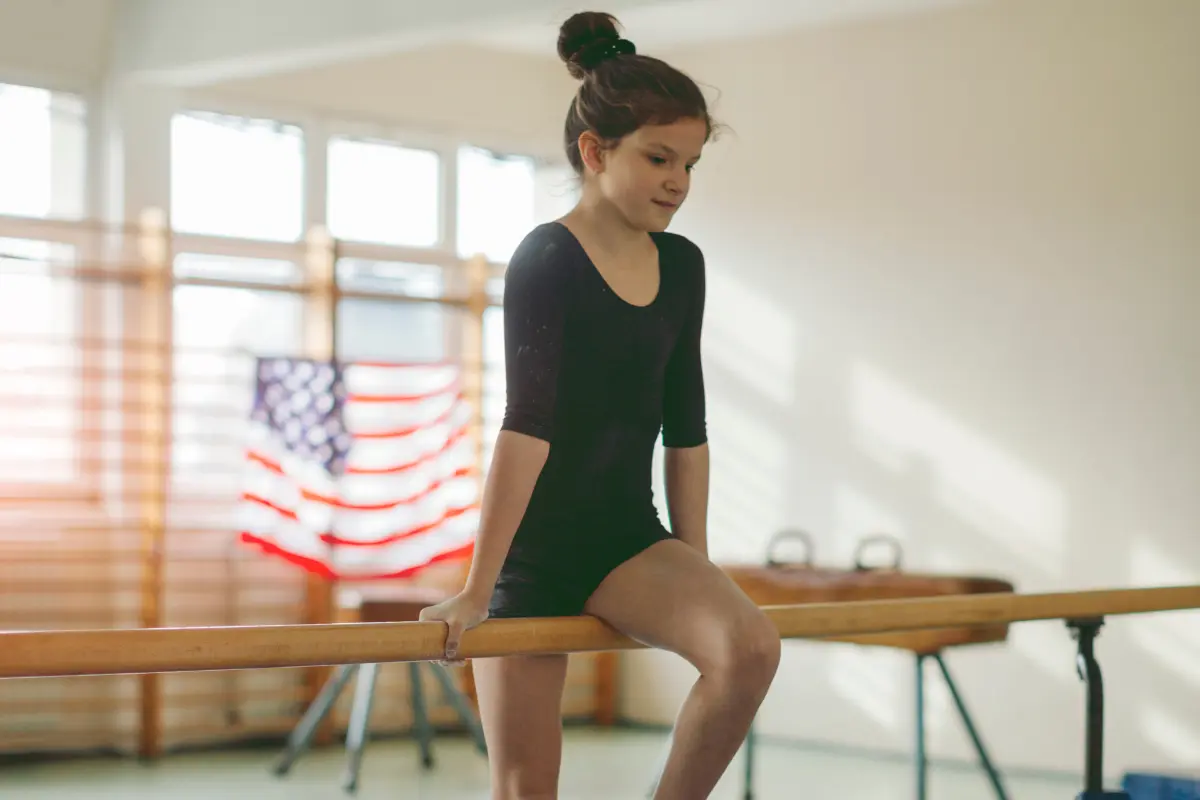Vault is one of the most exciting events in gymnastics—and for athletes in Levels 1 through 5, it’s all about building the basics. Each level introduces new challenges that help gymnasts develop strength, speed, body control, and confidence.
Let’s take a closer look at what each level requires and how gymnasts grow at every stage.
Contents
Level 1 Vault
Skill: Stretch Jump + Kick-to-Handstand, Flat-Back Finish
Level 1 vault is where gymnasts are first introduced to the essential elements of vaulting: a fast approach, strong takeoff, and controlled body movement through the air. In this skill, the gymnast sprints toward the springboard, performs a stretch jump onto a low mat stack (about 16 inches high), then kicks up to a handstand and finishes by falling flat onto their back in a tight, straight position.
- Mat Height: Approximately 16 inches
- Primary Focus: Body alignment, a strong kick to vertical, and a safe, clean fall
What judges want to see:
- A quick, accelerating run into the springboard
- A tight, straight body through the stretch jump phase
- A fully extended, vertical handstand before the flat-back fall
- Legs and feet together, with toes pointed during the landing phase
Common deductions include:
- Bent knees or hips during the jump (up to 0.50 off)
- Not reaching vertical in the handstand (up to 0.30 or more)
- Loose body position or separated legs in the fall phase
This vault helps young gymnasts get a feel for aggressive movement and inverted body positions, but without the pressure of going over the actual vault table. It’s also their first introduction to the concept of blocking—a quick push away from the hands—even if it’s done against soft mats instead of hard equipment.
Coaching Tip:
To build confidence and clean shapes, coaches often split the skill into two parts:
- Stretch jump drills: From springboard to stacked mats
- Handstand fall drills: Practiced on floor or soft incline mats
Mastering this foundation sets the tone for all vault progressions ahead.
Level 2 Vault
Skill: Jump to Handstand + Fall to Flat Back
In Level 2, the stretch jump is removed, and the gymnast now jumps directly from the springboard into a handstand on a raised mat stack before falling backward into a flat-back position. It’s a clean, streamlined skill—but one that puts greater emphasis on strength, precision, and control.
- Mat Stack Height: Between 32 and 48 inches
- Focus: A tight, vertical handstand with body tension throughout
What judges are looking for:
- A quick, explosive takeoff (or “punch”) from the springboard
- A fully extended, straight-line handstand with no arching or shoulder angle
- Tight legs and pointed toes through the entire motion
- A controlled and straight flat-back landing
Deductions to watch for:
- Bent arms or legs during the takeoff or handstand (up to 0.30)
- Not reaching vertical in the handstand (up to 0.30)
- Landing on the feet instead of the back (1.0 deduction—considered a fall)
This vault may seem simpler with fewer moving parts, but the expectations are higher. Gymnasts must create enough power from the board to drive into a controlled, vertical handstand. There’s no extra jump to build momentum, so the athlete must rely on an efficient run and a strong board contact.
Coaching Insight:
Level 2 is where gymnasts begin developing explosive power and shape awareness. Coaches often focus on drills like:
- Springboard punches to elevated mats
- Handstand holds on panel mats or floor
These help athletes understand body control and locking out the arms—critical skills as they move toward flight-based vaults in the next levels.
Level 3 Vault
Skill: Front Handspring Over a Resi-Mat Stack
Level 3 marks a turning point in a gymnast’s vault journey—it’s the first compulsory vault that involves real flight. In this skill, the gymnast performs a front handspring over a stack of mats or a resi-pit that’s at least 32 inches high, landing upright on her feet.
- Landing Surface: Resi-pit or stacked mats (minimum 32″ high)
- Skill Goal: Front handspring with clean technique and a safe, upright landing
Unlike Levels 1 and 2, where the gymnast finishes flat on her back, Level 3 introduces both aerial flight and landing impact, setting the stage for competition vaults using the actual vault table in later levels.
What judges are looking for:
1. Pre-Flight: A fast, hollow-body run and strong heel-drive onto the springboard are crucial. Lack of speed or body tension can result in up to 0.30 in deductions.
2. Support Phase (hand contact on mats): The arms and shoulders should be fully extended (180° line).
- Bent elbows can incur up to 0.50 off.
- Head touching the mat is a major error and results in a 2.00 deduction.
3. Post-Flight: The gymnast must block off the hands early—leaving the hands before vertical is required.
- A late block (pushing too late) can lose up to 1.00 in deductions.
- Judges also look for height off the stack and distance traveled in the post-flight phase.
The Level 3 vault is a bridge between foundational drills and true competitive vaulting. While the gymnast doesn’t yet vault over the table, the resi-mat setup allows her to practice a strong shoulder block and controlled landing without the fear of hard impact.
Coaching Note:
This is the phase where gymnasts learn to generate power through their shoulders, not just their legs. Coaches emphasize:
- Blocking drills on softer mats
- Shoulder-angle training
- Timing the push-off just before vertical
Perfecting these techniques here is essential for a smooth transition to the vault table in Level 4.
Level 4 Vault
Skill: Front Handspring over the Vault Table
Level 4 is where gymnasts begin vaulting over the regulation vault table, marking their first true introduction to the full competitive vault setup. The skill remains a front handspring, just like in Level 3, but the firmness and height of the table introduce new technical challenges—especially in timing the block and maintaining body tension.
- Skill Goal: Clean front handspring over the table with height, distance, and a controlled landing
- Vault Table Height: Typically set between 115–125 cm, adjusted based on the gymnast’s age and size
What judges are looking for:
1. Run & Pre-Flight:
The gymnast should approach with speed and purpose, converting horizontal momentum into a strong upward lift onto the table.
2. Support Phase (on the table):
The gymnast must leave the hands at or before vertical. A late block (pushing after passing vertical) can result in deductions of up to 1.00. Judges also want to see a tight body position and straight arms during contact.
3. Post-Flight & Landing:
The gymnast should rise visibly off the table in a straight-body flight, then land upright with feet together and under control. All previous deductions still apply—bent arms, piking, or leg separation—but now amplitude and dynamics are judged more critically.
Coaching Note:
This is where everything from the run to the block must come together smoothly. Coaches drill:
- Accelerated sprints with a strong hurdle
- Shoulder blocking mechanics
- Controlled landings with tight form
Building confidence and consistency at this level lays the groundwork for success in both compulsory and optional vaulting.
Level 5 Vault
Skill: Front Handspring (Higher Expectations, Same Skill)
In Level 5, gymnasts repeat the front handspring over the vault table, but with sharper judging standards and a greater emphasis on power, precision, and dynamics. The skill itself hasn’t changed from Level 4—but the way it’s evaluated certainly has.
- Vault Table Height: Typically remains around 115–125 cm, adjusted to the gymnast’s category
- Skill Goal: A technically clean front handspring with greater amplitude, longer post-flight, and a controlled landing
What judges are looking for:
1. Angle of Repulsion:
The most significant single deduction still stems from leaving the table too late—after vertical. The angle-of-repulsion deduction chart becomes stricter, with up to 1.00 off for delayed blocks.
2. Support Phase:
Judges want to see a confident push through the shoulders with no hesitation. Arm or head adjustments on the table can lead to form deductions.
3. Post-Flight:
There should be noticeable rise and travel in the flight phase. A flat or short post-flight loses amplitude and dynamic points.
4. Landing:
Small hops now carry more weight—each one can cost up to 0.15, and failure to control the landing loses more. However, a stuck landing can earn bonus in optional-level meets and helps set routines apart.
Level 5 is the final compulsory vault level, and it’s considered the technical capstone of the compulsory program. Gymnasts who can sprint with power, hit a vertical block, and land upright with minimal movement are well-positioned to begin more advanced vaults—like Tsukaharas, Yurchenkos, and front twisting vaults—in Levels 6 through 10 or the Xcel Sapphire Division.
Coaching Insight:
At this level, coaches shift their focus to:
- Maximizing run speed and board entry
- Fine-tuning block timing for optimal height and distance
- Training consistent stuck landings
A well-executed Level 5 handspring is a sign that a gymnast is ready to transition into the demands of optional vaulting.
Vault Progression from Level 1 to Level 5
| Level | Vault Skill | Equipment | Key Focus | Landing Type |
|---|---|---|---|---|
| Level 1 | Stretch Jump + Kick-to-Handstand, Flat-Back | Low Mat Stack (~16″) + Springboard | Body alignment, handstand shape, safe fall | Flat-back on mats |
| Level 2 | Jump-to-Handstand, Flat-Back | Raised Mat Stack (32–48″) + Springboard | Vertical handstand, tight form, body tension | Flat-back on mats |
| Level 3 | Front Handspring Over Resi-Mats | Resi-Mat Stack (≥32″) + Springboard | Shoulder block, flight, controlled feet landing | Upright on feet |
| Level 4 | Front Handspring Over Vault Table | Vault Table (115–125 cm) + Springboard | Repulsion by vertical, rise & distance, body line | Upright on feet |
| Level 5 | Front Handspring (Advanced Execution) | Vault Table (115–125 cm) + Springboard | Greater amplitude, dynamics, stuck landing | Upright on feet |
For more details on vault requirements and judging, check the official USA Gymnastics Compulsory Program guide.




